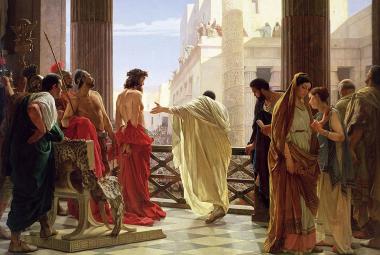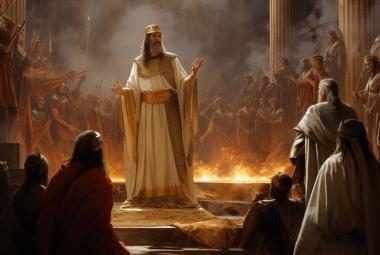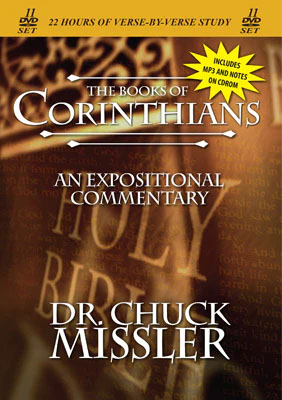The 15th chapter in 1 Corinthians is the most important chapter in the Bible (and the longest in this epistle). It deals with the ultimate enemy of mankind: death. It announces the death of death itself. This chapter is regarded by many as the Centerpiece of Christianity and the climax of Paul’s message.
The dream of immortality begins in the oldest book of the Bible:
For I know that my redeemer liveth, and that he shall stand at the latter day upon the earth: And though after my skin worms destroy this body, yet in my flesh shall I see God: Whom I shall see for myself, and mine eyes shall behold, and not another; though my reins be consumed within me.
Beginning with the Basics
What is the gospel? (“Good News”? No “cop-out” evasions here!) Paul gives it to us in a nutshell. We must first learn precisely what the gospel is.
Paul had already preached it.[1] After his Damascus conversion, Peter and James spent time with Paul in Jerusalem to fill in the details.[2] After 14 years passed, he returned to Jerusalem to confirm with the apostles whether his preaching was in harmony with the gospel they proclaimed.[3]
Three fundamental essentials:
1. First of all, Jesus died. (First in importance, not chronology. “Christ” (not “Jesus”): Paul uses his official title of the Messiah, our goel, the Kinsman-Redeemer.
He did not just disappear. The authorities (both Jewish and Roman) made sure that His death was undeniable! The authorities outwitted themselves when they took so many precautions to make sure Jesus was dead and remained in the grave!
Furthermore, Paul says twice in three verses “…according to the Scriptures (i.e., Old Testament).”[4] Jesus’ death and resurrection was not an afterthought. This was planned before the foundations of the world (and even hidden in the genealogy of Noah).[5] He died for our sins (not just died).”[6] The phrase “Christ died for our sins” is the doctrinal summary of the atonement:
- As our Substitute, Christ died to appease God and meet the demands of the law;[7]
- As our Advocate, He effected reconciliation and made us righteous before God;[8]
- As our Mediator, He established a new covenant and accepted us as partners;[9]
- As our Savior, He grants us eternal life through faith in Him.[10]
2. He was buried. Only Paul mentions the burial. It points backward to the reality of death and forward to the character of the resurrection. Paul even identifies the believer’s baptism with Christ’s burial.[11] Jesus’ physical body was placed in the tomb. On the third day a new glorified body came forth, no longer subject to time and space.[12] The Greek passive voice conveys the sense that God alone is the agent who creates life.
3. He was raised on the third day. The passive voice denotes the implied agent, God.[13] Translations fail to exploit the differences in Greek verb tenses between verses 3 and 4: The Greek uses the past tense to describe a single action in the past for Jesus’ death and burial. But for the verb “to be raised” the Greek has the perfect tense to indicate an action that occurred in the past but has lasting relevance for the present.[14] Jesus was raised from the dead and continues His life in the resurrected state.[15]
If the Roman or Jewish authorities could have produced the body of Jesus, all the rumors would have quickly stopped, and it all would have ended. But they could not. The empty tomb emphasizes that Jesus’ resurrection was physical! (It is emphasized in all four gospels that the body was missing).[16]
Omissions?
What is remarkable is what Paul does not include in his “Gospel.” He makes no mention of Jesus’ miracles, His teachings, or His examples. These are important, but not “the Gospel”! The focus is on three principal things: Jesus’ death, burial, and resurrection. These overshadow all other aspects of His ministry.
“Third day according to (which) Scriptures”? Jonah 1:17, linked with Matthew 12:40.[17] Jesus also taught that He would be killed and raised the third day.[18]
Other “Three Days” Examples
- Third day of Creation: Double Blessing;[19]
- the Akedah: Abraham’s Offering of Issac;[20]
- Joseph Interprets Two Dreams[21]
- Baker (bread) Dies on the Third Day
- Cupbearer (wine) Freed on the Third Day
- Crossing of the Red Sea: The Third Day after Passover; Departed from Mt Sinai;[22]
- Spies En Route From Jericho;[23]
- Jonah in the Great Fish;[24]
- Esther Fasts Three Days;[25]
- Wedding in Cana on the Third Day;[26]
- Christ Was Three Days in the Tomb;[27]
- Saul’s Blindness in Damascus;[28]
- Hosea: Israel’s Petition for Lord’s Return.[29]
After His resurrection, Jesus’ physical body could be touched,[30] could be recognized,[31] could come and go through locked doors,[32] and He could eat and drink with them.[33] Jesus’ resurrection body was transformed to transcend time and space.[34]
Appearances of Jesus
On that Sunday, Jesus appeared to the women; Mary Magdalene; two men on the road to Emmaus; Peter; and, the 10 disciples in the upper room.[35] Paul first mentions Peter, whom he usually calls Cephas, the Aramaic name for Peter.[36]
Sunday evening, the disciples in the upper room told the men from Emmaus that He had appeared to Simon.[37] That morning the angel instructed the women to tell the disciples “and Peter” to go to Galilee where Jesus would meet them.[38] There Jesus forgave Peter and reinstated him.[39] (The book of Acts reveals that immediately after Jesus’ ascension Peter became the undisputed leader in the Jerusalem church.)
Would you believe that JFK was shot with an arrow? Why not? Too many witnesses are still alive who know better! So, also, during the first century with respect to Jesus Christ: “Five hundred brethren at once.” (Nothing in the Gospels or Acts clearly corroborates the figure of 500 brothers. Some associate this with the closing words of Matthew’s Gospel and the great commission.) A crowd would not be surprising, since He announced this appearance through the women earlier. Most of the 500 were still living at the time Paul wrote this epistle (about 25 years after the crucifixion). Apparently both Paul and the Corinthians were acquainted with many of them.
Half a year before Jesus’ death, His brothers, including James, still did not believe on Him.[40] But immediately after Jesus’ ascension, His brothers believed and were with the apostles in the upper room.[41] James listened to Paul when the former persecutor returned to Jerusalem as a believer.[42] James filled Peter’s place when the apostle fled Jerusalem after his release from prison.[43] After his third missionary tour, Paul reported to James and the elders in Jerusalem.[44]
The Physics of Immortality
Frank J. Tipler, Professor of Mathematical Physics at Tulane University, is a major theoretician in the field of global general relativity, that rarefied branch of physics created by Stephen Hawking and Roger Penrose.
In devising a mathematical model of the end of the universe, Tipler (a professed atheist) came to a stunning conclusion: Using the most advanced and sophisticated methods of modern physics, relying solely on the rigorous procedures of logic that science demands, he created a proof of the existence of God.
Furthermore, he believes that every human being who ever lived will be resurrected from the dead. He claims that he arrived at his proofs of God and immortality “in exactly the same way physicists calculate the properties of an electron.” His book explains why he now believes that the central claims of Judeo-Christian theology are in fact true, and that these claims are straight-forward deductions of the laws of physics as we now understand them.
The Analogy of a Seed45
It is no more difficult to believe in the resurrection than it is to believe in a harvest! What emerges from a seed that “dies” is incomparably more glorious than what was planted. (Examples: bulbs vs. gladiolas, a butterfly, et al. …) Plants (and people) do not rise of their own volition, nor by chance. Only by the decisive (aorist) action of God.
Six is the Number of Man
Our DNA is a 3-out-of–4 error-correcting code, using the same for all. Digitally different, but yet by a common architect. At the cellular level, an intact human immune system will virtually always recognize and reject a nonhuman transplant as foreign. What is the underlying characteristic within humanity that speaks of our uniqueness?
On virtually every nucleated cell in a person are small markers (lipoproteins to be precise) called antigens. Their official designation is “histocompatibility antigen” or “human leukocyte antigen (HLA).” These certain antigens are the same in every human and are only found in humans, although given individuals may have different arrangements and collections of these molecules. (For example, these antigens are responsible for the different ABO and Rh systems important in blood transfusions.) The irony is that in every person, on virtually every cell, this marker of mankind is a product of one certain chromosome: Chromosome #6.
This system is the locus of genes that encode for proteins on the surface of cells that are responsible for regulation of the immune system in humans. This group of genes encodes cell-surface antigen-presenting proteins and has many other functions; and, it all resides on chromosome #6.
When we get our resurrection bodies, there will be no more experience of death, aging, crying, mourning, sorrow, or pain:[46] All believers will be given new bodies like the glorious body of the Lord.[47] Our new body will have a different dimensionality.[48] Our new, natural bodies will be “spiritual,” completely Spirit-filled and Spirit-governed. Our bodies have become temples of the Holy Spirit.[49]
Jesus emphasized that His new body is material (“flesh and bone,”[50] but with the Holy Spirit thoroughly filling and governing this body. Note: the Holy Spirit’s role in the Creation.[51]
Our physical bodies will be like His own.[52] “This mortal must put on immortality…” We cannot dress ourselves. God does it all. We are disconnected from our past (and even time itself).
O death, where is thy sting?
O grave, where is thy victory?
(Paul Quotes from the Old Testament.[53] Death’s days are numbered.)
The sting of death is sin; and the strength of sin is the law.
Here, in a single verse, Paul expresses the doctrine of sin, the law, and death. Two years later, Paul expanded the complete doctrine in his Epistle to the Romans.[54]
Three “Tenses” of Salvation
- “Been Saved”: Past tense. Regenerated by the Spirit. Aorist: once and for all. Spiritually linked to Jesus. The Shepherd keeps the sheep.
- “Being Saved”: Present tense. Growing as an instrument of His Grace. We are all “works in progress.” We need to apply our salvation to our lives. You may be saved, but what have you done since? It is possible to believe in vain. It is not just an “insurance policy” against going to hell.
- “Will be Saved”: Future tense. The resurrection.
Do you have your passport for the transit that’s coming?
This article has been excerpted from a double-session of our expositional commentary on 1 Corinthians 15:
- The Definition of the Gospel 15:1–12
- Death and Resurrection 15:13–25
- Christ’s Kingdom 15:25–35
- The Physics of Immortality 15:36–40
- The Resurrection Body 15:41–50
- The Harpazo 15:51–58
[The doctrine of the rapture is one of ecclesiology as much as eschatology! It may come as a surprise that it is seen in the Old Testament[55] as well as the New Testament.[56]]
Notes:
- Acts 13:30; Gal 1:1 ↩
- Gal 1:18–19 ↩
- Gal 2:1 ↩
- Isa 53:5–6, 8–9; Ps 22:16; cf. Mat 26:28; 1 Pet 3:18 ↩
- Cf. Gen 5 ↩
- Rom 5:8; 8:32; Gal 1:4; Eph 5:2; Titus 2:14 ↩
- Rom 3:25–26; 5:9–19 ↩
- 2 Cor 5:21; 1 John 2:1–2 ↩
- Luke 22:20; 1 Cor 11:25 ↩
- John 3:16 ↩
- Rom 6:4; Col 2:12 ↩
- John 20:19, 26; Luke 24:31 ↩
- Acts 3:15; 4:10; 5:30; 10:40; 13:30, 37 ↩
- vv. 12,13,14,16,17,20; cf. 2 Tim 2:8 ↩
- Rev 5:6 ↩
- Mat 28:5–6; Mark 16:5–6; Luke 24:3–4; John 20:6–8 ↩
- Also, Ps 16:8–11 with Ps 110:1; Some also point to Hos 6:2. Gen 22 is perhaps the most dramatic example: Abraham’s offering of Isaac. Isaac was “dead” to Abraham for three days: Heb 11:19 ↩
- Mat 16:21 ↩
- Gen 1:9–13 ↩
- Gen 22; Heb 11:19 ↩
- Gen 40:8–22 ↩
- Num 10:33 ↩
- Jos 2:16 ↩
- Jon 1:17 ↩
- Esther 4:16 ↩
- John 3:1 ↩
- Luke 24:21 ↩
- Acts 9:9 ↩
- Hos 5:15–6:3 ↩
- John 20:27 ↩
- (with difficulty) John 20:14–15; 21:4,7 ↩
- John 20:19, 26 ↩
- Luke 24:42–43; Acts 1:4; 10:41 ↩
- 1 John 3:2 ↩
- Mark 16:1–11; Luke 24:13–43 ↩
- John 1:42 ↩
- Luke 24:34 ↩
- Mark 16:7 ↩
- John 21:15–19 ↩
- John 7:5 ↩
- Acts 1:13–14; 1 Cor 9:5 ↩
- Gal 1:19 ↩
- Acts 12:17 ↩
- Acts 21:18–19 ↩
- John 12:24 ↩
- Rev 21:4 ↩
- Phil 3:21; 1 John 3:2 ↩
- 1 John 3:2 ↩
- 6:19, et al.. ↩
- Luke 24:39 ↩
- Gen 1:2 ↩
- 2 Cor 4:14; Col 1:18; Phil 3:20–21; 1 John 3:2; Rev 1:5 ↩
- Isa 25:8; Hos 13:14 ↩
- Rom 6:23; 7:9–11,13 ↩
- Isa 26:19–21, Zep 2:3, Psa 27:5 ↩
- 1 Cor 15:50, 51; 1 Thes 4:15–17 ↩







